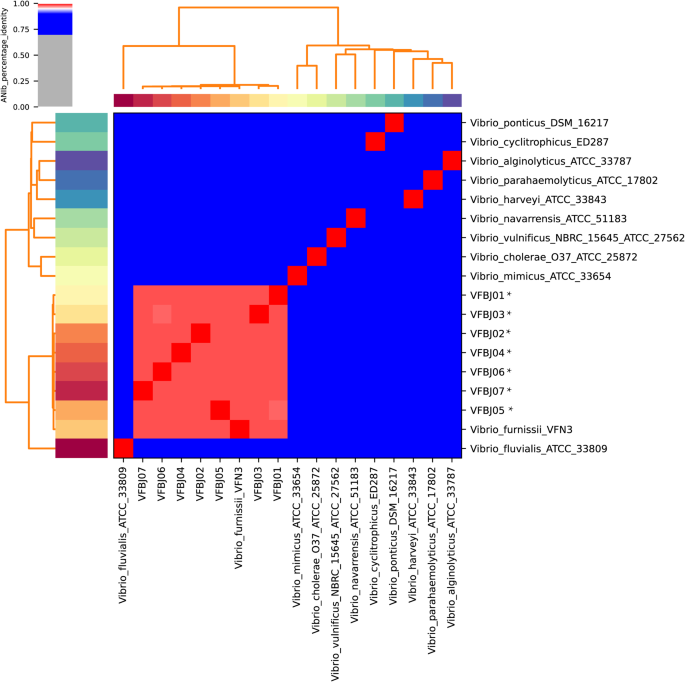𝘝𝘪𝘣𝘳𝘪𝘰 𝘧𝘶𝘳𝘯𝘪𝘴𝘴𝘪𝘪, an emerging human pathogen is associated with cases of acute gastroenteritis. While 𝘝𝘪𝘣𝘳𝘪𝘰 𝘧𝘶𝘳𝘯𝘪𝘴𝘴𝘪𝘪 infections are traditionally considered rare, recent discoveries of multidrug-resistant strains have raised concerns regarding their clinical significance. This report provides a comprehensive analysis of key scientific findings regarding 𝘝𝘪𝘣𝘳𝘪𝘰 𝘧𝘶𝘳𝘯𝘪𝘴𝘴𝘪𝘪 infections, antibiotic resistance mechanisms, and virulence characteristics.
Methods:
Seven 𝘝𝘪𝘣𝘳𝘪𝘰 𝘧𝘶𝘳𝘯𝘪𝘴𝘴𝘪𝘪 strains were isolated from patients presenting with acute diarrhoea at a general hospital in Beijing, China, between April and October 2018. Genome analysis, antimicrobial susceptibility testing, and virulence phenotype assays were performed to characterize the isolates. Phylogenetic analysis based on single-nucleotide polymorphisms (SNPs) was conducted to elucidate the genetic relationships among the strains.
Key Findings:
- Genomic Insights:
- Phylogenetic analysis revealed a close relationship between 𝘝. 𝘧𝘶𝘳𝘯𝘪𝘴𝘴𝘪𝘪 𝘢𝘯𝘥 𝘝. 𝘧𝘭𝘶𝘷𝘪𝘢𝘭𝘪𝘴 strains forming distinct monophyletic clades.
- Whole-genome sequencing identified transposon islands containing antibiotic resistance genes on multi-drug resistance plasmids and chromosomes, highlighting the potential for horizontal gene transfer and dissemination of resistance determinants.
2. Antimicrobial Resistance:
- 𝘝𝘪𝘣𝘳𝘪𝘰 𝘧𝘶𝘳𝘯𝘪𝘴𝘴𝘪𝘪 isolates exhibited high resistance rates to cefazolin, tetracycline, and streptomycin, with intermediate resistance to ampicillin/sulbactam and imipenem.
- Multi-drug resistance was observed in several strains, posing challenges for effective antibiotic therapy.
- Resistance to carbapenems, including imipenem and meropenem, was detected in VFBJ02, indicating the emergence of carbapenem-resistant 𝘝𝘪𝘣𝘳𝘪𝘰 𝘧𝘶𝘳𝘯𝘪𝘴𝘴𝘪𝘪 strains.
3. Virulence Phenotypes:
- 𝘝𝘪𝘣𝘳𝘪𝘰 𝘧𝘶𝘳𝘯𝘪𝘴𝘴𝘪𝘪 strains encoded key virulence factors, including the type VI secretion system (T6SS), haemolysins, metalloproteases, and iron-regulated outer membrane proteins.
- Phenotypic assays confirmed the expression of an active T6SS and strong beta-haemolysis on blood agar, suggesting potential pathogenicity in human hosts.
4. Clinical Epidemiology:
- Diarrhoea associated with 𝘝𝘪𝘣𝘳𝘪𝘰 𝘧𝘶𝘳𝘯𝘪𝘴𝘴𝘪𝘪 infections occurred sporadically, with cases more prevalent during the summer months in Beijing, China.
- Seafood consumption was identified as a potential source of 𝘝𝘪𝘣𝘳𝘪𝘰 𝘧𝘶𝘳𝘯𝘪𝘴𝘴𝘪𝘪 contamination, highlighting the importance of food safety measures.
- Treatment Implications:
- Fluoroquinolones and third-generation cephalosporins, such as ceftazidime and doxycycline, were effective in treating 𝘝𝘪𝘣𝘳𝘪𝘰 𝘧𝘶𝘳𝘯𝘪𝘴𝘴𝘪𝘪 infections.
- However, the emergence of multi-drug resistant strains underscores the importance of judicious antibiotic use and continuous surveillance efforts.
This study provides valuable insights into the genomic, antimicrobial resistance, and virulence characteristics of 𝘝𝘪𝘣𝘳𝘪𝘰 𝘧𝘶𝘳𝘯𝘪𝘴𝘴𝘪𝘪, shedding light on its clinical significance and potential treatment strategies. Continued laboratory-based surveillance is essential for monitoring the spread of antibiotic resistance and implementing effective control measures. Future research should focus on elucidating the molecular mechanisms underlying antibiotic resistance and virulence in 𝘝𝘪𝘣𝘳𝘪𝘰 𝘧𝘶𝘳𝘯𝘪𝘴𝘴𝘪𝘪 to inform targeted therapeutic interventions and public health policies.
Link to the article : https://tinyurl.com/y5efysea
